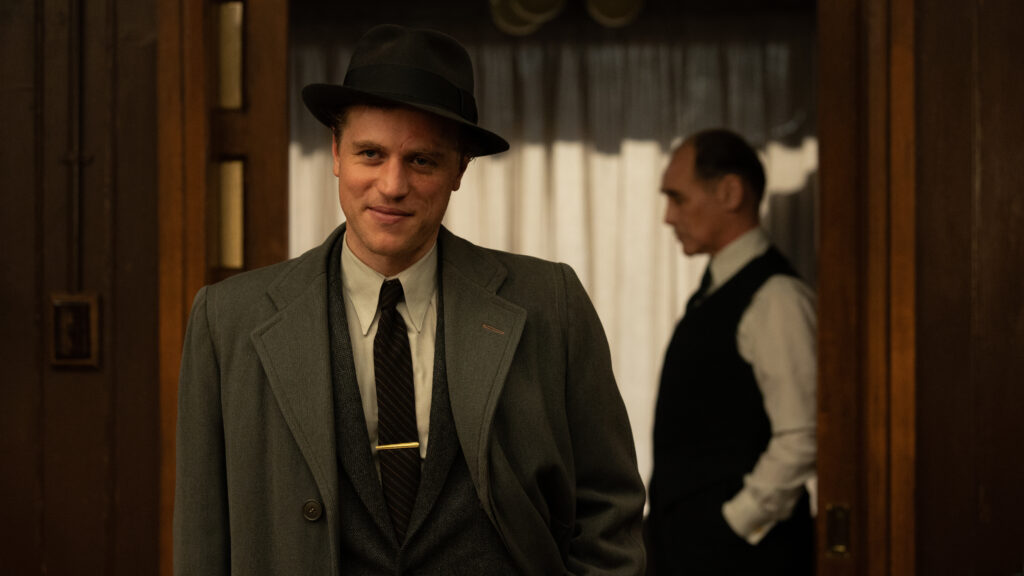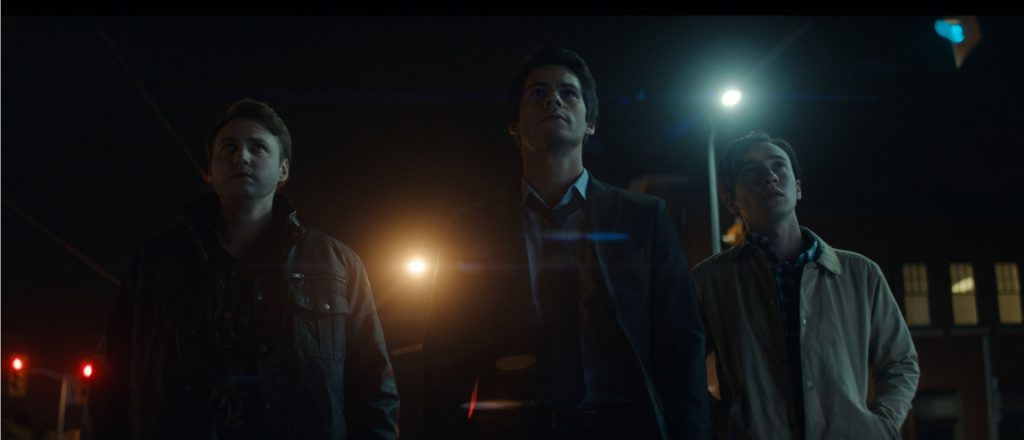March 18, 2022
by Carla Hay

Directed by Graham Moore
Culture Representation: Taking place in Chicago in 1956, the dramatic film “The Outfit” features a predominantly white cast of characters (with a few African Americans) representing the working-class, middle-class and criminal underground.
Culture Clash: A mild-mannered British man, who owns a men’s clothing shop in Chicago, has local gangsters as his clients, and he becomes embroiled in the gang’s problems.
Culture Audience: “The Outfit” will appeal primarily to people who like watching above-average mystery thrillers that have some unpredictable plot twists.

The suspenseful thriller “The Outfit” keeps viewers guessing about who are the heroes and who are the villains. It’s a well-crafted movie with a very talented cast that brings impressive energy to this unique story. If people ever say that good old-fashioned mystery films aren’t being made anymore, then point them in the direction of “The Outfit.” It pays homage to Alfred Hitchcock-influenced films of the mid-20th century while avoiding being a misguided, “stuck in a time warp” mess.
“The Outfit,” which takes place in 1956, is the feature-film directorial debut of Graham Moore. He won an Academy Award for Best Adapted Screenplay, for 2014’s “The Imitation Game,” another well-made movie about an intelligent British man who gets caught up in a web of lies and treacherous conspiracies. Moore co-wrote the “The Outfit” screenplay with Jonathan McClain.
Unlike the sprawling settings of “The Imitation Game,” the setting of “The Outfit” is contained entirely in one place: the small clothing shop of Leonard Burling (played by Mark Rylance), a British immigrant who has been living in Chicago for the past several years. It would be easy for viewers to assume that “The Outfit” was adapted from a stage play, but this movie has an original screenplay.
Leonard’s specialty is high-priced, custom-made men’s suits. He also does clothing repairs. He’s very meticulous and takes pride in his work. He’s also quick to tell people that he’s a cutter, not a tailor. As time goes on in the movie, viewers see that the movie’s title of “The Outfit” has a double meaning: the type of clothing that Leonard can make and the gang syndicate that causes the dangerous predicament that Leonard becomes involved with in this movie.
Leonard is a reclusive, middle-aged bachelor with no children. He lives alone in a back area of the shop. Leonard has one employee: a woman in her 20s named Mable (played by Zoey Deutch), who is the shop’s administrative assistant/receptionist. She has a perky personality and is very reliable. However, Mable is honest in telling Leonard that she doesn’t love his line of work and only has this job to make enough money to pay her bills. Her dream is to travel around the world, including go to Paris, a city that has a special place in her heart.
Leonard tells people that he moved from the United Kingdom to Chicago because the popularity of denim clothing made his bespoke line of work fairly obsolete in his native country, where he used to have a shop on London’s Savile Row. Leonard’s reason for immigrating to America doesn’t sound very plausible, because denim clothing is popular in the United States too. Leonard is very private and doesn’t divulge much about his personal life, although he mentions that he served in the British military during World War I.
Among the people who are Leonard’s loyal clients are some local Irish gangsters. Leonard stays out of the gang’s dirty dealings and doesn’t pass judgment. The wealthy Irish mob boss in the area is named Roy Boyle (played by Simon Russell Beale), who doesn’t appear until about halfway through the movie. Roy is grooming his only son Richie Boyle (played by Dylan O’Brien), who’s in his 20s or early 30s, to eventually take over the gang’s business.
However, Richie has a rival for this position of power: a cunning manipulator named Francis (played by Johnny Flynn), who’s about five to eight years older than Richie. Francis was orphaned at an early age and taken in by Roy as somewhat of a foster son. Francis is as cold and calculating as Richie is hot-headed and impulsive. Richie feels a lot of jealousy and resentment toward Francis, whom Richie suspects is his father Roy’s top choice to be Roy’s successor as the mob leader. Richie gripes to Leonard about Francis: “He not even Irish!”
Something happens during this story that forces Leonard to be caught in increasingly elaborate deceptions and traps involving a coveted surveillance tape and a missing person. Complicating matters, Francis and Mable are romantically involved with each other. All of the cast members give exemplary performances, but Rylance is the obvious standout because his Leonard character is the most complex. Nikki Amuka-Bird shares top billing in “The Outfit” as an enigmatic woman named Violet, but viewers should know that Violet gets very limited screen time (about five minutes) toward the end of the film. After a somewhat slow-paced start, “The Outfit” goes on a thrilling ride that keeps viewers on edge throughout this entire memorable mystery.
Focus Features released “The Outfit” in select U.S. cinemas on March 18, 2022. UPDATE: Peacock will premiere “The Outfit” on May 2, 2022.




